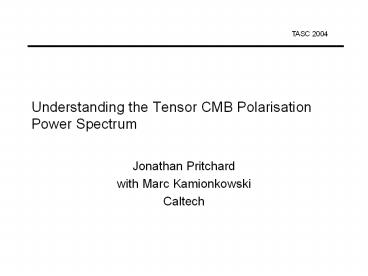Understanding the Tensor CMB Polarisation Power Spectrum PowerPoint PPT Presentation
1 / 9
Title: Understanding the Tensor CMB Polarisation Power Spectrum
1
Understanding the Tensor CMB Polarisation Power
Spectrum
- Jonathan Pritchard
- with Marc Kamionkowski
- Caltech
2
Overview
- Have been attempting to develop analytic
expressions for the tensor CMB power spectrum. - Analytic expressions aid intuition and give
insight into results of numerical calculations. - Today will discuss only polarisation power
spectrum. - B-mode polarisation current target of
observational effort.
Tensor power spectra
3
CMB Polarisation Introduction
- Primordial plasma cools leading to recombination.
e p -gt H - Photon mean free path increases.
- CMB originates at the surface of last scattering
(SLS). - Inflationary tensor perturbations to metric
stocastic gravitational wave background. - Time evolving gravitational potential generates
temperature perturbations via Integrated
Sachs-Wolfe (ISW) effect. - Thomson scattering of anisotropic temperature
distribution generates polarisation. - Resulting polarisation spectrum decomposed into E
(grad) and B (curl) modes.
4
Structure of the problem
- Decompose T and polarisation perturbations using
Legendre polynomials,e.g., - Solving equations for radiation transport then
gives polarisation multipoles
Visibility Function
Geometric Projection
Source Evolution
5
Geometric Projection
- 3D Fourier modes projected onto 2D angular
scales. - Aliasing Single Fourier mode contributes to many
angles. Peak at - Projection terms involve spherical Bessel
functions, oscillate and are messy to calculate. - Approximate Bessel functions using Debyes
asymptotic formula. - Average over oscillation to get polynomial
envelope.
6
Growth of Anisotropy
- Before recombination radiation and baryons are
tightly coupled and the photon mean free path is
small. - Increasing photon m.f.p. allows growth of
anisotropy. - Resulting multipole depends on the strength of
sourcing term and the time its had to grow. - Little power on large scales where gravitational
wave varies little across width of SLS.
7
Gravitational Wave Evolution
- Gravitational waves evolve according to damped
wave equation - After horizon entry g.w. amplitude redshifts as
- Expansion rate depends on radiation/matter
content. - Scaling relation for amplitude
- Use lk (lookback) to get scaling for
polarisation power spectrum . - Redshifting of g.w. leads to decrease in power on
scales smaller than the horizon scale at
recombination.
8
Phase damping
- On small scales the tensor mode varies rapidly
over the width of the SLS. - Coherent scattering of photons from regions of
different phase leads to cancellation. - Exponential damping of multipoles
- Suppression of power on small scales.
9
Conclusions
- Combining all the physics mentioned can derive
semi-analytic expressions for the power spectra. - Without phase damping recover appropriate
scaling relations. - With phase damping see rapid drop in power on
small scales. - Projection approximations only valid llt600.
- Wiggles contain information about evolution of
gravitational waves in the early universe.

